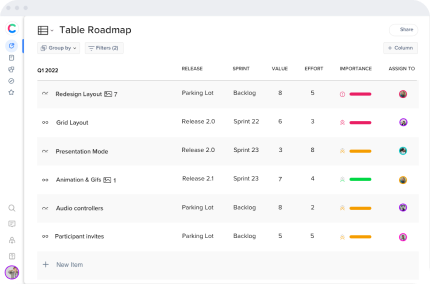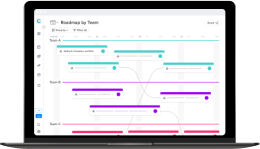What is user experience?
A user experience (UX) is the overall impression and feeling a person has when interacting with your product or service. It covers everything from how it looks and works to how it helps users reach their goals. A great user experience goes beyond visuals and design by creating a smooth and enjoyable journey before, during, and after someone uses your product.
But what is UX for product owners? Delivering strong UX is essential; it drives adoption, builds loyalty, and supports long-term growth. When a product feels intuitive, efficient, and accessible, users can focus on achieving their goals and feel confident every step of the way.
The importance of user experience
As mentioned earlier, the definition of user experience is the process of designing products that are easy, enjoyable, and valuable for users to interact with. Therefore, as a product owner, you want to build solutions that truly matter to your users and keep them coming back. A pleasant user experience will inspire a customer to interact with your product regularly and in multiple ways.
A negative user experience, on the other hand, can be annoying, perplexing, and even lead to mistakes being committed. A user dissatisfied with your user experience will simply switch to a competitor’s product due to your poor user experience.
Putting user experience at the heart of your process is key, because it directly shapes your product’s impact and growth. Here are the user experience basics:
- Increase User Adoption: When your product is easy to use and understand, people are more likely to try it, stick with it, and realize its value faster.
- Reduce Churn: Delightful experiences keep users engaged and loyal, making them less likely to leave for alternatives.
- Boost Customer Loyalty: Happy users become your advocates, spreading the word and helping your brand grow organically.
- Streamline Onboarding: A clear and supportive onboarding journey gives new users the confidence and know-how to get started quickly.
- Drive Business Metrics: Positive UX lifts engagement, conversion, and lifetime value, directly fueling your business goals.
Who is in charge of the user experience?
To keep up with the rising discipline of improving user experience, numerous new job roles have been formed to handle the duty of user experience. Most frequently, a user experience designer is entrusted with understanding what people want and need from a product and turning this vision into a reality through design.
Creating an excellent user experience is a shared responsibility, but the main focus typically falls on the UX designer. Their role is to understand what users need, what problems they face, and how they interact with a product. This often begins with user research, where designers observe and speak with users to uncover real insights rather than relying on assumptions or personal opinions.
Once this research is complete, UX designers collaborate closely with UI designers to bring those insights to life. While the UX designer shapes the flow and structure of the experience, the UI designer focuses on how the product looks and feels. Together, they create interfaces that are intuitive, consistent, and visually engaging.
These roles work side by side throughout the design and development process, ensuring every interaction feels natural and purposeful.
UX Designers and Product Managers: Working Hand in Hand
Both UX designers and product managers share a common goal: creating value from the user’s point of view. Product managers define what the product should achieve and why it matters, while UX designers determine how to make it happen through thoughtful design.
For example, if users struggle to navigate a music app, the UX designer might suggest clearer visual cues and simpler workflows. The product manager then ensures this improvement is prioritized in the next update. Together, they deliver better products, encourage stronger collaboration, and create more meaningful experiences.
Essential pillars of UX design
Designing and refining user experience means considering every step of the user journey. A successful user experience is built on several key elements that work together to make products both effective and enjoyable to use.
- Usability: Making it easy for users to accomplish their goals throughout the customer journey with clear navigation, logical workflows, and intuitive controls.
- Accessibility: Ensures your product is inclusive and usable by everyone, including people with disabilities
- Visual Design: Crafting an appealing, consistent interface that builds trust and guides users naturally.
- Information Architecture: Organizing features, content, and navigation so users always know where to find what they need.
- Performance: Keeping your product fast, reliable, and responsive so users stay engaged and frustration-free.
- Feedback and Support: Offering clear guidance, helpful error messages, and accessible support so users always feel supported.
- Emotional Impact: Designing experiences that are not just functional, but also enjoyable, meaningful, and motivating.
How to improve the user experience of your product
If you want to build a product that attracts the right users and keeps them engaged, it must be designed around their needs. A smooth and intuitive user experience can make the difference between a product that users love and one they quickly abandon.
Consider this example: as a product manager for a travel app, your goal might be to simplify the booking process. If users have to click through endless screens, face hidden fees, or struggle to find key information, frustration builds and trust erodes. Instead, by removing unnecessary steps, making pricing transparent, and keeping navigation simple, you create an experience that feels effortless and reliable.
Good UX design focuses on removing friction, minimizing cognitive load, and helping users reach their goals with confidence. Small improvements like faster load times, mobile-friendly layouts, and clear messaging can significantly boost satisfaction and retention.
Here’s how to create an exceptional user experience:
- Start by understanding your users through research, interviews, surveys, and testing. This helps you uncover their real needs and challenges.
- Next, design with users in mind by involving them early and often in the process so their feedback shapes your decisions.
- Then start testing and improving continuously. Use what you learn to refine your product as it evolves
- Make accessibility a priority so everyone can use your product comfortably and effectively.
- Build trust through transparency by avoiding manipulative design choices that put business goals over user needs.
- Finally, encourage teamwork between product, design, engineering, and support teams to stay aligned and deliver consistent value to users.
In other words, if you invest in creating a great user experience, your product will not only be more engaging and pleasurable for people to interact with, but it will also be more commercially successful as a result of your efforts.
Bringing it all together: The power of user experience
User experience is about more than one interaction or feature; it covers the entire journey a user takes with your product. A great UX combines usability, emotional value, and a deep understanding of user pain points and motivations. It’s about creating an experience that feels seamless, rewarding, and purposeful from start to finish.
At the same time, strong UX supports your brand’s goals. Even the best-designed product can fall short if users struggle to engage or convert. That’s why user experience designers play such a vital role in shaping digital products that not only meet business objectives but also deliver lasting value to users.
FAQ
What are the main elements of user experience?
The main elements of user experience include usability, accessibility, visual design, information architecture, performance, feedback and support, and emotional impact. Craft.io helps product teams address each of these elements by providing tools to centralize feedback, visualize user journeys, and monitor UX metrics.
Why is user experience important for product management?
User experience is crucial because it directly influences user adoption, retention, loyalty, and overall business success. With Craft.io, product managers can put UX at the heart of their process, leading to happier users and stronger product outcomes.
What are the common challenges product owners face with UX?
Product owners often struggle with understanding user needs, managing fragmented workflows, aligning stakeholders, balancing priorities, and maintaining ethical, user-focused design.


